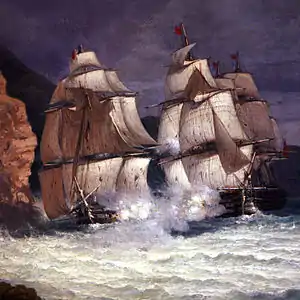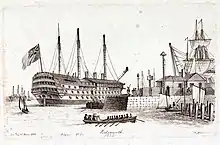 | |
| History | |
|---|---|
| Name | HMS Boyne |
| Ordered | 25 June 1801 |
| Builder | Portsmouth Dockyard |
| Laid down | April 1806 |
| Launched | 3 July 1810 |
| Renamed | HMS Excellent, 1834 |
| Fate | Broken up, 1861 |
| General characteristics [1][2] | |
| Class and type | Boyne-class ship of the line |
| Tons burthen | 2155 bm |
| Length | 186 ft (57 m) (gundeck) |
| Beam | 51 ft 5 in (15.67 m) |
| Depth of hold | 22 ft (6.7 m) |
| Propulsion | Sails |
| Sail plan | Full-rigged ship |
| Complement | 738 (650 razeed) |
| Armament |
|
HMS Boyne was a 98-gun second rate ship of the line of the Royal Navy, built by Nicholas Diddams at Portsmouth Dockyard[3] and launched on 3 July 1810 at Portsmouth.[1] On 12 February 1814 she took part with HMS Caledonia in a hot action against the French line-of-battle ship Romulus off Toulon; the French 74 managed to escape to Toulon by sailing close to the coast to avoid being surrounded. With the 1817 changes to the rating system Boyne was rerated as a 104-gun first rate ship.[2]
On 23 November 1824, Boyne was driven ashore at Portsmouth during a gale.[4] In 1826 she was cut down (razeed) to become a two-deck, 76-gun third-rate ship of the line.[2] On 1 December 1834 she was renamed HMS Excellent and became a training ship. On 22 November 1859 she was renamed HMS Queen Charlotte and paid off the following month before being broken up from December 1861.[1][2]

Notes
References
- Lambert, Andrew (2012). The Challenge: Britain Against America in the Naval War of 1812. London: Faber and Faber. ISBN 0-571-27319-X
- Lavery, Brian (2003) The Ship of the Line - Volume 1: The development of the battlefleet 1650–1850. Conway Maritime Press. ISBN 0-85177-252-8.
- Winfield, Rif (2008): British Warships in the Age of Sail: 1793 - 1817. Seaforth Publishing. ISBN 978-1-84415-717-4.
External links
 Media related to HMS Boyne (ship, 1810) at Wikimedia Commons
Media related to HMS Boyne (ship, 1810) at Wikimedia Commons